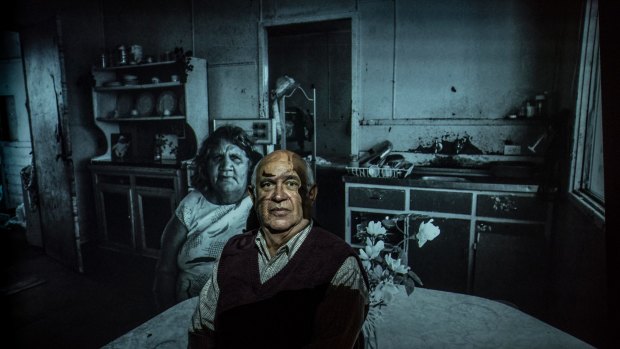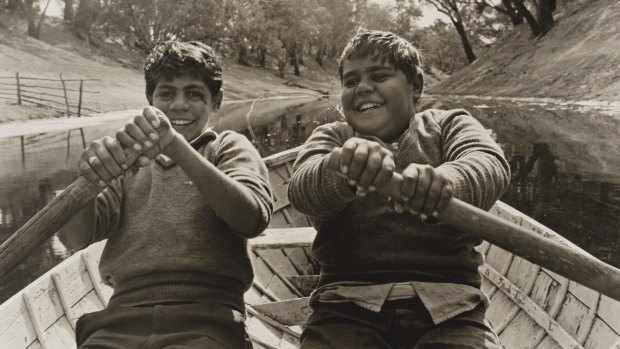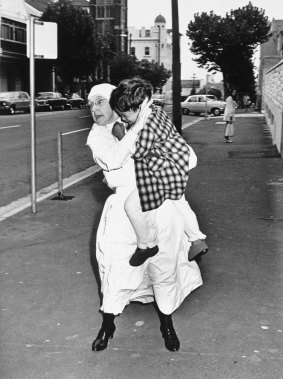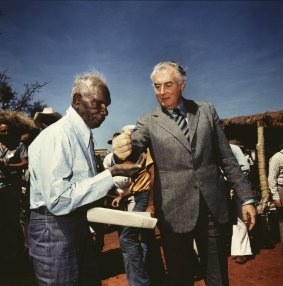By Peter Munro
When Mervyn Bishop was a boy, his family hosted slide nights in the backyard at Brewarrina, in north-west NSW, projecting his photographs onto an old sheet strung on the clothesline.
The scrolling black-and-white images showed his dad smoking in the shearing shed, his sister skylarking by the river, his cousins climbing a tree. Neighbours came to watch the show. His mother Marjorie served tea and biscuits.
Bishop enjoyed mucking about on his mum's Kodak 620 folding camera. A local council worker built a makeshift darkroom in a spare bedroom and showed the teen how to develop pictures.
This is better than magic, Bishop thought.

Bishop with his 1988 photograph "Cabbage Tree Island", at the Art Gallery of NSW.Credit: Steven Siewert
"I couldn't get enough of it, I was hooked," he says.
Those intimate photographs are at the heart of the eponymous exhibition Mervyn Bishop, at the Art Gallery of NSW. The collection of more than 100 images is a tribute to Australia's first Aboriginal press photographer and an award-winning visual storyteller.
Bishop's 60-year career has helped chronicle the history of this nation and its Indigenous people, in the big cities and the bush. But he's drawn back to those early family photos.
I ask him to nominate an important image. He points towards his joyous 1966 picture of two boys in a boat on the Barwon River. They're his cousins, Ralph and Jim Richardson, mucking about in their school uniforms.

Bishop's photo of his cousins Ralph and Jim Richardson in a boat on the Barwon River in 1966.Credit: Mervyn Bishop
"We were out at a property outside Brewarrina. They wagged school that day," he says.
"We were out there in the shearing shed messing about, then they spied a boat down by the river. So we all jumped in and I took this lovely photo."

Bishop's 1971 photograph "Life and death dash". Credit: Mervyn Bishop
Bishop, who turns 72 in July, is better known for grander landscapes, such as his 1975 photo of then prime minister Gough Whitlam pouring soil into the hand of Gurindji elder Vincent Lingiari, to mark the return of his people's traditional lands in the Northern Territory.
The iconic image was a do-over. The action initially took place in the shade of a shed. Bishop asked the two men to repeat the moment out in the sun, under a bright blue sky. "Will this do?" Whitlam asked him, bending down to collect a second clump of soil.

Bishop's 1975 photo of Vincent Lingiari and then prime minister Gough Whitlam.Credit: Mervyn Bishop
The exhibition also features Bishop's 1971 photo Life and death dash, of a nun rushing a crying child to hospital, in Darlinghurst. The image was published on the front page of The Sydney Morning Herald. Bishop was awarded News Photographer of the Year.
Great photographs capture moments of great drama, he says.
"It's the look on her face, it's the child crying ... It's kind of magical," he says. "There are many parts of a great photograph. It has got to affect people. It might show a mood; a feeling of serenity, quietness, sadness, happiness."
Many of his photographs are on show for the first time, sourced from the thousands of images he keeps in boxes and filing cabinets at home in Dubbo. There's Bishop the young cadet photographer at work in 1964. In a three-piece suit on his wedding day to Elizabeth in 1970. Playing golf with his young daughter Rosemary. Hugging his son Tim at a weekend soccer game.
The exhibition also features several of Bishop's old cameras and that 35mm slide projector, which displayed his early photographs in the backyard at Brewarrina. Bishop still enjoys "puddling around" in darkrooms, processing black-and-white photographs, just like he did as a boy.
"It's a lasting thing," he says. "Colour pictures fade, they just don't look right. But the black-and-white will be here for hundreds of years."
He hopes his own photographs will last long after he has "left the building". "I've kind of made a mark in history," he says. "It's not just about my family and my personal events, it's about parts of the history of Sydney and around this country that I have captured. The visual image of the country in my lifetime."
That's a good thing to leave behind, I say. "It's a wonderful thing," he says.
The exhibition Mervyn Bishop is at the Art Gallery of NSW until October 8. Bishop will host a special slide night of his photographs at the gallery on July 5 at 6.30pm.